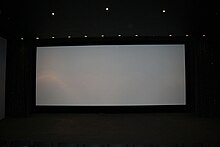Widescreen format
Widescreen formats are formats for cinema films (mostly 35 mm), which became widespread in the 1950s. This describes all image formats that are wider than the so-called normal image or academy ratio (1.33: 1 or 1.37: 1). The most common widescreen formats are the non- anamorphic formats European widescreen format (1.66: 1) and American widescreen format (1.85: 1) and the anamorphic formats such as Panavision or Cinemascope (2.35: 1). The 16: 9 format (1.78: 1) also exists in the television sector. Although rare, 16 mm anamorphic film copies also exist .
Non-anamorphic wide screen
Films for this format are recorded in the normal format and shown in the projection using a mask and lamination in the 1.66 or 1.85: 1 format. Since around 1970 the majority of films have been designed for widescreen projection. On many, but not all, film copies, the parts of the picture at the top and bottom that should not be shown are covered in black. It is not uncommon to recognize films that were designed for widescreen projection but mistakenly shown either in normal format or instead of 1.85: 1 in 1.66: 1 by the frequently visible microphones or spotlights at the top and bottom of the picture. On many cardboard boxes of film copies you can still find the label "Flat" - this describes a film that is intended for non-anamorphic showing.
Anamorphic wide screen
In order to fit on a conventional film negative with a ratio of 1.33: 1, the widescreen format is reproduced normally using special camera optics in the vertical image axis, but compressed in the horizontal one. So there is a deliberate photographic distortion. The optics for this technique are called anamorphic lenses (ana = up, up; morphae = shape). A well-known supplier of anamorphic lenses is the US camera manufacturer Panavision , which does not sell them, only rents them. They offer the advantage of making full use of the film negative, but they require more light than conventional optics. In order to convert the laterally squeezed 35 mm film negative or positive back into a natural image with an aspect ratio of 2.35: 1, the cinema projectors must also be equipped with an anamorphic lens.
Superscope
The Superscope format was a specialty of production. The films were shot with non-anamorphic recording technology in normal format (1.33: 1), but later anamorphic copying was made in the laboratory to format 2.0: 1. In the cinema, a Superscope film such as a Cinemascope or Panavision film with an anamorphic attachment was projected. As a result, image information was lost at the upper and lower edge of the image, but this - as with the European and American widescreen formats - was already taken into account when rotating the image composition.
See also
- Aspect ratio
- Anamorphic procedure
- Cinerama
- VistaVision
- Superscope
- Cinemiracle
- 70mm film
- Lamination
- Image window
literature
- James Monaco: Understanding Film. Rowohlt, Reinbek near Hamburg 1980, ISBN 3-499-16271-7 .
Web links
Individual evidence
- ↑ History of Cinemascope, Panavision and other anamorphic widescreen formats on Widescreenmuseum.com
- ↑ Explanation of the Superscope format on Widescreenmuseum.com


